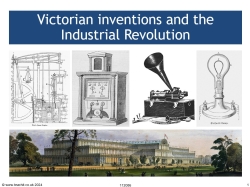Victorian inventions and the Industrial Revolution

This Victorian inventions and the Industrial Revolution lesson consists of an engaging PowerPoint and comprehensive worksheet, providing an in-depth exploration of the technological advancements during the Victorian era and their impact on society.
What’s included?
- PowerPoint covering key aspects of the Industrial Revolution and specific Victorian inventions
- Editable or free PDF worksheet with scavenger hunt questions about the inventors and their inventions
- Extension activities to encourage further thought and discussion about the impact of these Victorian inventions
Ideas for teaching KS2 children about the Industrial Revolution
The PowerPoint guides you through the key aspects of the Industrial Revolution, beginning with an overview of the era and progressing to the specific inventions that propelled societal change. The accompanying worksheet provides scavenger hunt questions to encourage active learning, with children identifying the inventors, describing the inventions, and explaining their significance.
You might also be interested in How to be a Victorian millionaire, a game-based activity that explores the entrepreneurs and Victorian inventors making their fortunes during the Industrial Revolution. For KS3 resources, try our Industrial Revolution collection for KS3 history.
What was the Industrial Revolution?
The Industrial Revolution was a transformative period from the late 1700s to the early 1900s that began in Britain. It marked the transition from handmade goods to machine-produced items in factories. This period revolutionised people's lives entirely, with inventions like the steam engine and the telegraph central to these changes.
What were some of the most important Victorian inventions?
The lesson resources cover eight pivotal Victorian inventions, including the steam engine, the telegraph, photography, the sewing machine, dynamite, the internal combustion engine, the phonograph, and the electric light bulb. Each invention is contextualised with information about the inventor, its functionality, and its impact on Victorian life. The worksheet encourages children to delve deeper into these inventions, promoting critical thinking about their importance and the ways they shaped the world we live in today.
The lesson resources conclude with extension activities that promote further thought about the implications of these inventions on everyday life, encouraging children to consider which invention brought about the most significant change and how each invention built upon the previous ones.
Eight significant Victorian inventions featured in this lesson:
- Steam Engine (1781): James Watt made big changes to the steam engine in 1781. This machine helped start the Industrial Revolution. Steam engines helped power trains, ships, and factories, making work faster and easier during the Victorian era.
- Telegraph (1837): Sir William Fothergill Cooke and Charles Wheatstone invented the telegraph. This amazing invention let people send messages over long distances in a few minutes. Before the telegraph, it took days or even weeks! The telegraph helped businesses, spread news, and let people chat from far away.
- Photography (1839): Louis Daguerre in France and William Henry Fox Talbot in England introduced photography. Now, people could take pictures and see the world in a whole new way. It wasn't so expensive, so lots of people could do it. This had a big effect on how people lived in the Victorian era.
- Sewing Machine (1846): Elias Howe invented the sewing machine. This made making clothes a lot faster and cheaper. This led to the birth of ready-to-wear fashion. Because of this, people in the Victorian era could dress in new and different ways.
- Dynamite (1867): Alfred Nobel invented dynamite. This was a safer and easier way to make things explode compared to what was used before. This invention was really important for building things, mining, and wars during the Victorian era.
- Internal Combustion Engine (1876): Nikolaus Otto made the internal combustion engine, a big improvement over the steam engine. This invention led to the creation of modern cars and changed how people travelled in the Victorian era.
- Phonograph (1877): The phonograph was made by Thomas Edison. This was the first device that could record and play back sound. This invention let people listen to music at home and changed how people lived in the Victorian era.
- Electric Light Bulb (1879): Thomas Edison and Sir Hiram Maxim both made practical electric light bulbs around the same time. These bulbs made it possible for people to do things even when it was dark, made life safer, and changed how cities looked at night during the Victorian era.

